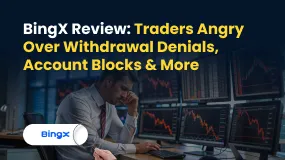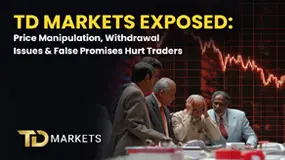简体中文
繁體中文
English
Pусский
日本語
ภาษาไทย
Tiếng Việt
Bahasa Indonesia
Español
हिन्दी
Filippiiniläinen
Français
Deutsch
Português
Türkçe
한국어
العربية
Are Your Heirs' Finances In Trouble? How Bitcoin and Forex are Handling Them
Abstract:Both the cryptocurrency and foreign exchange markets have become more interwoven in recent years. Their link is not insignificant: Forex alone has a daily trading volume of 6.6 trillion USD, with an absolute value of 2.41 quadrillion USD.

On the other hand, the still-young cryptocurrency market has a daily trading volume of 45 billion USD, 95% of which is made up of stablecoins. Stablecoins are digital currencies that are tied to traditional fiat currencies such as the USD or EUR. Hybrid currency trading pairings such as BTCUSD (bitcoin and the US dollar) or ETHUSD (Ethereum and the US dollar) have become increasingly popular on cryptocurrency exchanges and Forex brokerage firms alike.
With the recent collapse of the FTX crypto exchange, a long list of problems was exposed, putting many traders and investors on hold or on high alert. Although some media sites portray the whole affair as evidence of bitcoin's and blockchain technology's fundamental systemic vulnerability, the reasons for this scam must be characterized as human malice, greed, and perhaps some mistake on the side of some lesser players.
Remember, Remember the Fall of FTX at the Beginning of November
On November 2, 2022, a Coindesk post sparked widespread attention to FTX's dubious financial status. What gradually emerged in the days that followed was an extremely shaky, very suspect, and most likely fraudulent corporate structure that was rotten at the core—with co-founders involved in the spectacularly massive loss and disappearance of cash.
Because the investigation into the FTX fallout is continuing, drawing conclusions or rendering final judgments is premature at this time. However, all retail customers, totaling over one million individuals, who used FTX's services have lost their money. The total amount is more than $1 billion USD, with individual lawsuits attempting to recover much more than $100,000. Generational family savings and pension money have been wiped out.
As of this writing, over 30 billionaires have claimed to have lost substantial assets as a result of it, which begs the question of who the insiders were—withdrawing in time—if even billionaires were unaware of what destiny would shortly befall their cash.
This case and the findings of the current investigations will last until at least 2023, if not longer.
USD and the FED Rate Hike Marathon in 2022
Since March 17th, the U.S. The Federal Reserve has raised interest rates every 4 to 6 weeks, beginning with a 25 basis point increase from 0.25% to 0.50%. Throughout the summer and into November, the rate reached a stunning 4.00%. The FED's previous four rate rises were each by 75 basis points, indicating an extremely tight and urgent monetary policy.
The USD appreciated as a result, but economic growth has slowed as well. Nonetheless, the globally ubiquitous ailment of inflation has not been healed. However, Europe is suffering much more than the United States from increasing costs, particularly in the energy industry. However, slowing the rate of price rises proved much more difficult than predicted.
However, bitcoin and the whole crypto market, like the stock market, have plummeted throughout the full year of 2022. Almost as if the processes of fiat currency inflation and stock and crypto market depreciation had a strict link to persist. The structural interdependence of both domains—the foreign exchange market and the cryptocurrency market—was at its most intimate in 2022: a historical bear market run, if there ever was one. Will a global economic bull market cause both realms to advance together, or will one win over the other?
Bitcoin has lost 70% of its value since December 20, 2021.
The world's first cryptocurrency started its current downward trend at the beginning of December 2021, when it fell to 56,900 USD (from an all-time high of 67,500 USD on November 9, 2021)—a decrease of about 16%. Following then, there was a frequently steady, sometimes sharp downward trend to 16,840 USD on 30 November 2022—another 70% drop.
In contrast to the frantic and joyful 'year of the bull' in 2021, this tale serves as a sobering wake-up call for retail and public attitude. Some even say that this is another damage to blockchain's general legitimacy. Since bitcoin's creation, the asset appreciation chart has been clear: BTC is a historically reliable and credible long-term inflation hedge. Despite the inflationary pressures, the USD outperforms bitcoin in terms of currency appreciation this year.
Experienced Forex traders and investors took advantage of the now-clear 2022 trend and gave the USD the benefit of the doubt over bitcoin.
At the same time, bear in mind the most recent Goldman Sachs statements on the US dollar's impending peak: their estimates indicate that this peak is just a few quarters away, after which a recession might ensue. During this period, asset prices will be significantly revalued in relation to the US dollar.
Despite the bleak present, finance's future seems promising.
The current global financial and economic difficulties will ultimately pass. The cyclical nature of the phenomenon ensures it. After the night comes the day, and the bull follows the bear. A new synthesis in the international order will usher in a new period of financial prospects. One such possibility is the bitcoin halving projected for April 2024, which analysts say would offer the popular cryptocurrency a big boost to growth around mid-2023. If this is shown to be true, many will see the present moment as a 'buy-the-dip' opportunity.
In hindsight, with 2022's large bitcoin volatility inflicting harm even at the state level—as in El Salvador—high-profile voices have begun to argue for stronger regulation rather than outright governmental rejection. Certain expert schools of thought regard the likelihood of additional regulation as a positive development. More regulation might help remove investor apprehension in the future, erasing connotations with the IT and blockchain industry as a bursting bubble, and that development is also conceivable based on forthcoming state-organized assurances and oversight.
Another major signal is that, notwithstanding the FTX disaster, the whole month of November has witnessed a massive top-up of bitcoin reserves by centralized crypto exchanges. So the game is far from over—quite the contrary.
Stay tuned for more Forex news.
Download the WikiFX App from the App Store or Google Play Store to stay updated on the latest news.

Disclaimer:
The views in this article only represent the author's personal views, and do not constitute investment advice on this platform. This platform does not guarantee the accuracy, completeness and timeliness of the information in the article, and will not be liable for any loss caused by the use of or reliance on the information in the article.
Read more

CMS Prime Review: Traders Report Withdrawal Blocks, Fund Scams & Unprofessional Support
Is your CMS Prime forex trading experience financially distressing? Does the broker constantly deny you to withdraw your funds? Has the broker defaulted on swap charges? Has the CMS Prime scammed you at every stage of your forex journey with it? Do you also have to witness unprofessional behavior from the broker officials? Well, these trading issues have become headlines on the CMS Prime broker’s review platforms. We have shared some complaints in this CMS Prime review article. Read on!

BingX Review: Traders Angry Over Withdrawal Denials, Account Blocks & More
Are BingX officials with you when you lose your trade? Do these officials apply restrictions on withdrawals as you earn profits? Do you lose access to BingX com login after earning profits? Does the US-based forex broker block your trading account in such situations? Failing to get key trading data access from the broker? These issues have been affecting many traders at BingX. In this BingX review article, we have shared some complaints. Take a look!

TD Markets Exposed: Price Manipulation, Withdrawal Issues & False Promises Hurt Traders
Is your winning trade converted into a loss upon closing it at TD Markets due to heavy price manipulation? Is withdrawing funds too much of a hassle at this South Africa-based forex broker? Does even the customer support fail to respond to your withdrawal requests? Have you been defrauded on the promise of zero commission upon withdrawal? Have you failed to close the trade due to the systemic issue at TD Markets? You are not alone! Many traders have commented while sharing the negative TD Markets review. We have shared some of them in this article. Take a look!

B2PRIME Retail Brings Pro-Level Trading to Everyone
B2PRIME unveils B2PRIME Retail, delivering pro-level execution and transparent pricing to retail traders with institutional-grade tech and multi-asset offerings.
WikiFX Broker
Latest News
Private payrolls rose 42,000 in October, more than expected and countering labor market fears, ADP says
Yields Rise, Rate-Cut Odds Slide As ISM Services Survey Signal Inflation Fears
Op-ed: The fuel for the AI boom driving the markets is advertising. It is also an existential risk.
Stonefort Broker Review 2025: Legit or Risky? A Complete Analysis
The United States Outgrows All Its Major Peers
PINAKINE Broker India Review 2025: A Complete Guide to Safety and Services
PINAKINE Broker Review: A Complete Look at Its Services and Risks
Voices of the Golden Insight Award Jury - Simon So, Chief Experience Officer of Hantec Financial
Seychelles FSA Flags Clone Website Impersonating Admiral Markets
Canary Wharf Address Scam Resurfaces: FCA Exposes 20+ Clone Template Forex Platforms
Currency Calculator



